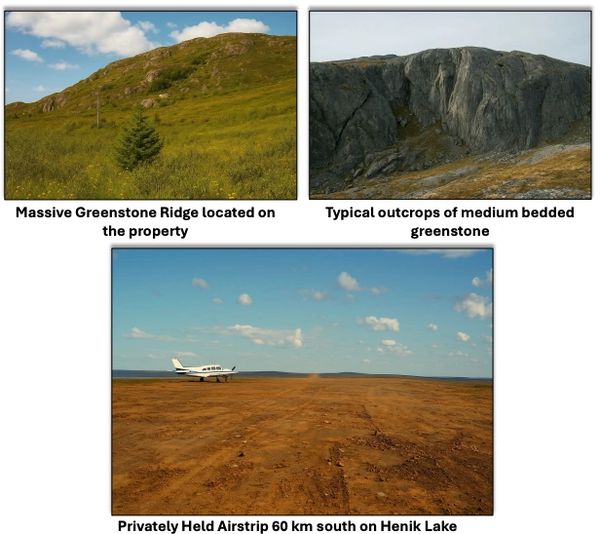SY Property: High-Grade Gold Exploration in Nunavut

Why it’s Compelling
District-scale footprint: ~45,984 ha across 44 mineral claims in the Yathkyed Lake Greenstone Belt, geologically analogous to Meadowbank and Meliadine, two of Nunavut’s marquee gold camps. Proven gold endowment: >40 documented high-grade gold occurrences and ~20 high-grade showings over ~30 km of strike, with historic surface samples reaching up to 38.8 g/t Au. Historic intercepts already in hand include: 3.38 g/t Au over 3.5 m and 3.18 g/t Au over 7.0 m from 1986 drilling, as well as 3.53 g/t Au over 6.2 m, including 5.67 g/t Au over 3.0 m from 1987 drilling at Jaeger East. Modern geophysics enhances our understanding: A 2006 DIGHEM V airborne survey outlined 690 EM conductors, many coinciding with iron formations and contacts, which are classic settings for BIF-hosted gold deposits. In 2007, confirmation and new showings were reported with 102 rock grabs; 13 samples showed >1 g/t Au, and five samples exceeded 5 g/t Au, reaching up to 8.88 g/t Au. This validates the geophysical targeting approach and reveals new sulphide zones in iron formation and metavolcanics.

Where The Ounces Could Come From
Banded Iron Formation–hosted lodes: Multiple horizons (oxide & silicate facies) with sulphides, arsenopyrite, and strong deformation, exactly the kind that hosts high-grade gold occurrences like those found at Meadowbank/Meliadine. Conductive, magnetic corridors: The 690 EM anomalies + linear magnetics define numerous untested bedrock conductors that align with the BIF/sulphide model, which is critical for Nunavut gold exploration in the Yathkyed Lake Greenstone Belt.

Why it Hasn’t Been Drilled Out Yet
The combination of poor exposure and a historic data gap has hindered the potential of high-grade gold occurrences in the region. Extensive till cover and the absence of a comprehensive modern program until the 2006–2007 work have left Nunavut gold exploration largely untapped. With little to no exploration since 1987, this area, particularly the Yathkyed Lake Greenstone Belt, presents an underfollowed, data-rich opportunity that is ripe for systematic follow-up.

Immediate Value Catalysts
Tight ground geophysics over priority EM/mag trends are essential for ranking conductor clusters for drilling, particularly in the context of Nunavut gold exploration. Systematic soils/frost-boil geochem will help extend the 2007 success beneath cover and identify potential high-grade gold occurrences. Focused Phase-1 drilling will target the best conductor, BIF, and geochem overlaps to replicate and extend the historical high-grade intercepts within the Yathkyed Lake Greenstone Belt.

Key Takeaways
SY already checks the boxes: scale, multiple high-grade gold occurrences, and a modern geophysical pipeline of 690 untested EM targets in the Yathkyed Lake Greenstone Belt. With minimal modern drilling, the discovery curve in Nunavut gold exploration is wide open.

Project Readiness & Exploration Upside
The SY Property is a high-value, drill-ready exploration opportunity in Nunavut's Yathkyed Lake Greenstone Belt, which is known for its high-grade gold occurrences. This region shares significant geological characteristics with major Canadian gold deposits, including Meadowbank (>4 Moz Au) and Meliadine (>6 Moz Au). The belt is notable for both orogenic gold and VMS-style polymetallic mineralization, making it a prime site for Nunavut gold exploration.

Historic Results & Proven Prospectivity
Over 3,500 metres of historic drilling has been completed across multiple target zones within the Yathkyed Lake Greenstone Belt, revealing over 40 documented high-grade gold occurrences along a greater than 12 km mineralized corridor. Historical drill intercepts include impressive results such as 3.53 g/t Au over 6.2 m and 3.38 g/t Au over 3.5 m. Additionally, surface rock samples have returned remarkable values of up to 38.8 g/t Au, 274 g/t Ag, and significant Cu, Pb, and Zn values, further enhancing the prospects of Nunavut gold exploration.

Geophysics-Driven Targeting Strategy
A 2006 airborne magnetic and EM survey (1,178 line-km) conducted in the Yathkyed Lake Greenstone Belt identified 690 EM conductors—many of which are aligned with iron formations and volcanic contacts. Field validation during Nunavut gold exploration in 2007–2008 confirmed multiple conductors, leading to the discovery of new sulphide zones. Notable rock samples from 2007 included high-grade gold occurrences, with 13 samples exceeding 1.0 g/t Au, including one sample that recorded an impressive 8.88 g/t Au, alongside values of up to 1,902 ppm Cu and 6,321 ppm Zn.
Copyright © 2025 Highland Critical Minerals - All Rights Reserved.
This website uses cookies.
We use cookies to analyze website traffic and optimize your website experience. By accepting our use of cookies, your data will be aggregated with all other user data.